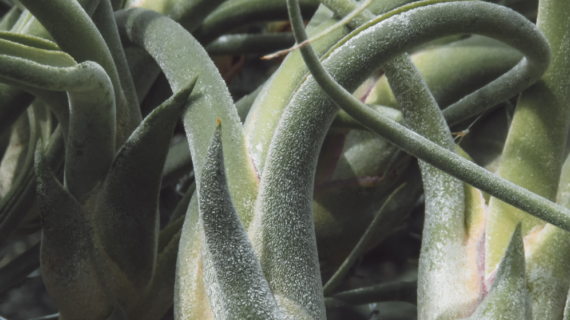
Trichomes are microscopic, hair-like structures that cover the leaves of Tillandsia. They play a vital role in absorbing water, nutrients, and even light. Although trichomes are present in many types of plants, Tillandsia trichomes are particularly specialized for life without soil.
Each trichome consists of a small, hair-like cell with a disc-shaped base that attaches to the leaf surface. When exposed to moisture, these cells open up to absorb water and nutrients, and then close to prevent dehydration in dry conditions. Trichomes are crucial for the survival of air plants in their natural habitats, which range from rainforests to deserts.
The Functions of Trichomes in Tillandsia:
- Water Absorption: Trichomes capture and absorb water from rain, mist, and humidity in the air.
- Nutrient Uptake: They trap and absorb essential nutrients from dust particles and organic debris.
- Sunlight Reflection: Trichomes reflect excess sunlight, protecting the plant from UV rays and preventing water loss.
How Trichomes Absorb Water

Unlike most plants, which use their roots to absorb water from the soil, Tillandsia use their leaves for hydration. Here’s how the process works:
Collecting Moisture: Trichomes are designed to capture and absorb even the smallest droplets of water, whether from rainfall, morning dew, or the surrounding humidity. In humid environments, Tillandsia can thrive solely on moisture from the air.
Water Absorption: When water touches the trichomes, they expand and open up, allowing moisture to seep into the cells. This water is then transported through the leaves to hydrate the plant’s tissues, supporting photosynthesis and other vital processes.
Drying Out: Once the water is absorbed, the trichomes close back up, sealing in the moisture and preventing evaporation. This feature allows Tillandsia to withstand periods of drought, as they are able to retain moisture for extended periods.
Why This is Important
This adaptation to absorb water directly through the leaves allows Tillandsia to grow in environments where other plants struggle, such as on tree branches, rocks, and cliffs. In these locations, water is scarce, and soil is usually absent. Trichomes enable air plants to make the most of any available moisture and survive in challenging conditions.
How Trichomes Capture Nutrients

Tillandsia trichomes not only capture water but also nutrients from the air. In their natural habitats, these plants often grow high in the canopy or on rocky surfaces, where they lack access to nutrient-rich soil. Instead, they rely on nutrients carried by dust particles, organic debris, and rainwater.
Trapping Dust and Organic Matter: Trichomes trap tiny particles of dust, decomposing organic material, and other nutrient sources that settle on the plant’s surface. These particles dissolve when it rains, and the nutrients are absorbed along with the water.
Absorbing Essential Nutrients: The trichomes absorb essential nutrients like nitrogen, potassium, and phosphorus, which are crucial for plant growth, reproduction, and health.
Storing Nutrients: Tillandsias don’t need large amounts of nutrients. The nutrients absorbed by trichomes are stored and used slowly, supporting steady growth without needing a continuous nutrient source.
Trichomes make it possible for Tillandsia to thrive in diverse climates—from humid rainforests to arid deserts. In each environment, trichomes play a slightly different role to help the plant adapt.
Humid Environments
In humid, tropical environments, Tillandsia benefit from regular rainfall and high humidity levels. The trichomes in these plants act as “sponges,” quickly absorbing moisture and nutrients. The reflective nature of trichomes helps prevent damage from intense sunlight, ensuring the plant doesn’t lose too much water through evaporation.
Dry and Arid Environments
In arid regions, where water is scarce, trichomes are essential for capturing even the smallest amounts of moisture from the air. Tillandsia species that grow in desert-like conditions often have thicker trichomes, which give them a silvery or fuzzy appearance. These trichomes help trap morning dew, fog, and any available humidity, ensuring the plant can survive during prolonged dry spells.
Trichomes are the secret behind Tillandsia’s ability to thrive without soil. These tiny structures enable air plants to absorb water, gather nutrients, and reflect sunlight, helping them survive in challenging environments. By understanding the function of trichomes, you can better care for your Tillandsia and keep them healthy. With the right watering, light, and air circulation, you can enjoy these fascinating plants as they thrive and beautify your space.